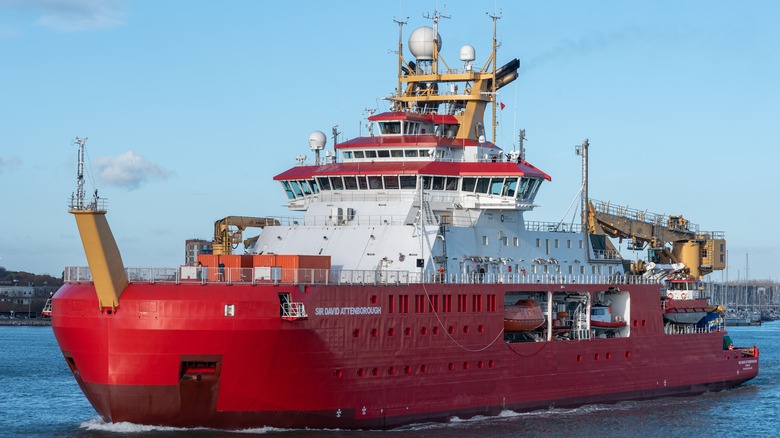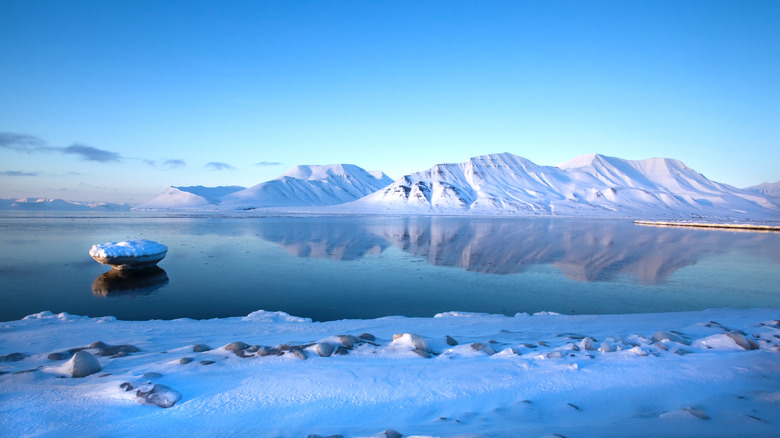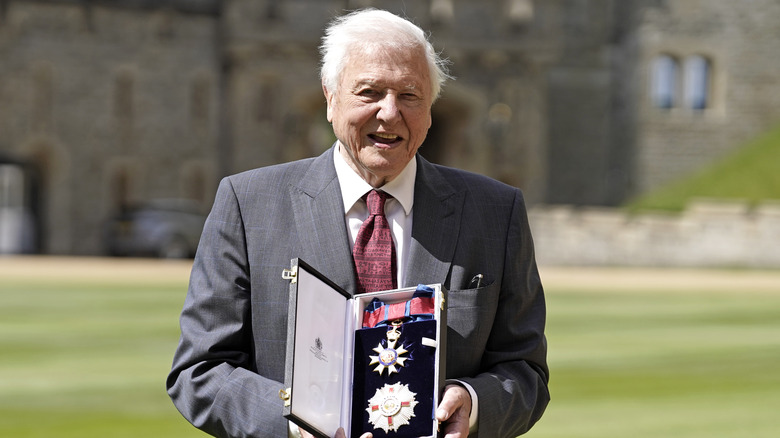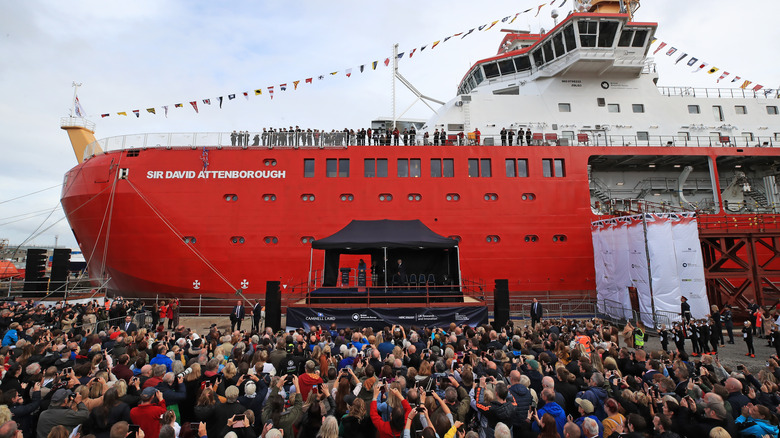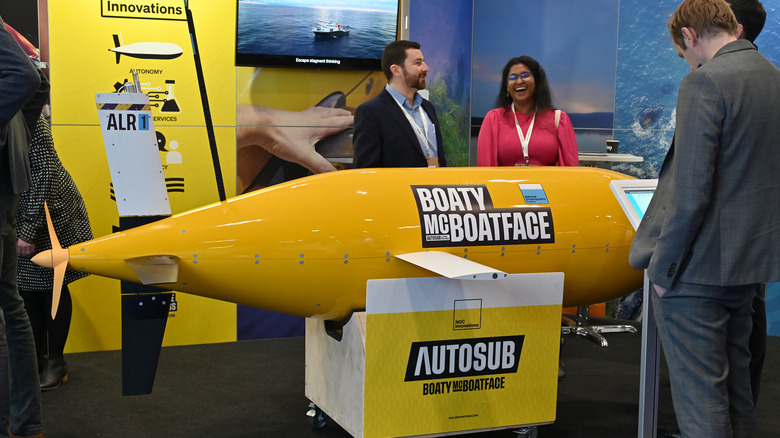The Hilarious Story Of Boaty McBoatface
When you think about it, it's kind of weird that we give boats names. Sure, it makes recordkeeping and nautical navigation easier than if a boat was just called "my boat" or "this boat, here." Plus, they don't get mass-produced like cars, so there's no series of Mazda Superliner VI vessels prowling the oceans. And yet, some boats have weirder and funnier names than others. A quick search online reveals some zingers like "The Codfather," "The Flounder Pounder," and the "Knotorious F.I.S.H.," which definitely deserves some kind of prize.
Recently, though, one seagoing name rose above others when the U.K.'s Natural Environment Research Council (NERC) took an online poll in 2016 asking netizens to toss some names in the hat for a new polar research vessel. In an instance of the digital hive mind rising to the occasion, favorites included "I Like Big Boats and I Cannot Lie," "What Iceberg," "It's Bloody Cold Here," and "Clifford the Big Red Boat" (yes, the boat was red). The winner at 33% of total votes, though, was "Boaty McBoatface." It definitely ranks up there with "Doggy McDogface" as a dog name.
Sadly, Boaty McBoatface's tongue-in-cheek victory didn't last. The NERC pivoted from the fan-favorite moniker and settled on something more illustrious, but definitely less amusing: the Royal Research Ship (RRS) Sir David Attenborough. Yes, that's Attenborough the famed narrator and natural historian often found gushingly musing on the wonders of the natural world. And yet, Boaty McBoatface lives on in probe form.
Prowling the polar regions
The RSS Sir David Attenborough — formerly Boaty McBoatface — is a polar research vessel, which as The Verge quips, means it researches "polar science stuff." But the specifics of the specs, capabilities, and mission of the U.K.'s NERC shiny new polar boat are impressive beyond the comedy surrounding its name.
The RSS Sir David Attenborough joins the British Antarctic Survey (BAS) to study the effects of commercial fishing and climate change on marine ecosystems near Antarctica, focusing on the impact of the rapidly melting West Antarctic Ice Sheet. The ship is basically a 420 foot-long, 15,000 ton science lab with 8,000 square feet of lab space and nearly 9,700 square feet of cargo space. It's got twice as many researchers (60) as it does crew (30), and was designed to roam the seas 60 days at a time and cut through ice over 3 feet deep. It's expected to stay in use for about 25 years.
The equipment on board is cutting edge, as the BAS explains, particularly its detachable Autonomous Underwater Vehicles (AUVs) and Remotely Operated Vehicles (ROVs) that act like probes gathering data for the mothership. The boat links to satellites, has multiple laboratories for inspecting samples, can analyze atmospheric gases, uses "seismic air guns" to test the geological composition of the ocean floor, has cameras that can penetrate up to 20,000 feet below the ocean's surface, and much more. Ultimately, the RSS Sir David Attenborough is a fitting name.
A landslide naming victory
At this point the original poll posted on the British Antarctic Survey's website is gone and replaced with detailed information about the RSS David Attenborough, including tons of cool pictures — and yes, the boat even has a helipad on it. Boaty McBoatface was an early naming favorite, a designation that sounds like the vessel was "christened by a 5-year-old who has drunk three cartons of Capri-Sun," as The Guardian puts it.
Polling for the vessel's name started in March 2016, a decision that some of those involved might have come to regret. This is particularly true of Duncan Wingham, head of the U.K.'s National Environment Research Council (NERC), upon whose burdened head the final naming decision fell. At the time, NERC openly praising the "enthusiasm and creativity" of those who put forth suggestions, as The Guardian quoted NERC's Alison Robinson. Some suggested names, she said, were "unusual but we're pleased that people are embracing the idea in a spirit of fun." Those suggestions included "Big Shipinnit, Science!!!," "Big Metal Floaty Thingy-thing," and the "RRS Sandeep Korotana" put forth by one Sandeep Korotana.
Polling closed on April 16, 2016. Boaty McBoatface won by a landslide at 124,109 votes, followed by the sobering RSS Poppy-Mai, named after a 16-month old child diagnosed with cancer. The RSS David Attenborough actually made fifth place, but still wound up cinching NERC's final decision.
The pivot to Attenborough
Because it's possible some readers might not know who David Attenborough is — and therefore might not appreciate why he won out over the magnanimous Boaty McBoatface — it pays to outline precisely how legendary and long-lasting of an inspirational public figure Attenburough is, particularly in his native England. Rather than starting as a scientist and making his way into media-related spheres like Neil deGrasse Tyson, Attenborough more or less started his career in television. However, he did graduate from Cambridge in 1947 with a degree in natural sciences. Five years later he joined the BBC as a producer, and from that point stayed on one monumental career track: Educating the public about the natural world through television and film.
Attenborough's first long-lasting series was "Zoo Quest" from 1954 to 1963, which took him to Indonesia, Guyana, and Sierra Leonne at a time when there was no internet to handily check out pictures or look up information about such places. Attenborough left the BBC in 1973 and produced a prodigious amount of independent, travel-oriented nature shows. By 1985 he was knighted by the British crown, and he continued to teach about our planet all the way into his 90s in shows like "The Blue Planet," "The Life of Mammals," "Planet Earth," "Life in Cold Blood," "Frozen Planet," and many more. In other words, if any oceanic research vessel could capture a sense of exploration and wonder, it would be a boat named after David Attenborough.
Launched in 2018
The Sir David Attenborough was launched in 2018, two years after the public decided it ought to be named Boaty McBoatface. In 2016 BBC presenter James Hand applauded the masses of namers and voters by calling Boaty McBoatface a "brilliant name" and the campaign to name the vessel "a very British thing," per The Guardian. Nonetheless, in the competition between the dignity and reputation of the U.K.'s NERC and the public's sense of humor, the former won out.
The full 2018 launch ceremony involved quite a few speeches and focused on the vessel's important role in uncovering information about climate change. Sir David Attenborough himself was in attendance (the vessel had been named by then) and crucially said of the boat's mission (per Discover Wildlife), "The Antarctic, far from being remote and desolate, is key to understanding what is happening in the entire globe and happening here. What we do effects what goes on down there."
At this point those attending the ceremony launched the boat, which involved pushing a big green button. Sadly, Attenborough didn't push it, but the boat was nonetheless released and slid off of its ramp and into the River Mersey off the town of Birkenhead across from Liverpool where it was built. Once afloat, the ship steered through the river a bit and was actually pushed into position at its dock by a smaller support vessel. Sea trials began in 2020.
McBoatface journeys on
People being what they are, folks sadly lost interest in Boaty McBoatface once its original naming contest finished. Nonetheless, the boat set out to sea after some COVID-19 delays that pushed the official polar research start to late 2021. While we don't have any details on the boat's current research, we can tell you precisely where the vessel is. Royal Museums Greenwich has a GPS-driven ship finder that, at the time of writing, shows the RSS David Attenborough near Tierra del Fuego in southern Argentina. Its speed is 15.2 knots, its course 40.2 degrees, and its next port Rothera Research Station, Antarctica.
Fans of Boaty McBoatface can forgot all this serious stuff and rejoice, however, as the name of the vessel lives on. Remember the RSS David Attenborough's Autonomous Underwater Vehicles (AUVs)? Well, in 2017 the National Oceanographic Centre announced that three of its own AUVs would carry the Boaty McBoatface moniker. These robotic probes — 11.5 foot-long, torpedo shaped vessels — have been proudly combing Earth's oceans for the past five years and boldly going where it would be difficult for humans to go, like 25 miles under Antarctica's ice shelves. Basically, the three Boaty McBoatfaces collect data on seabed shape, ocean temperature, salinity, and so forth. With increased technological capabilities, these and future Boatfaces can act even more autonomously and do even more of that aforementioned "polar science stuff." All in all, that's a legacy that would make even David Attenborough proud.
